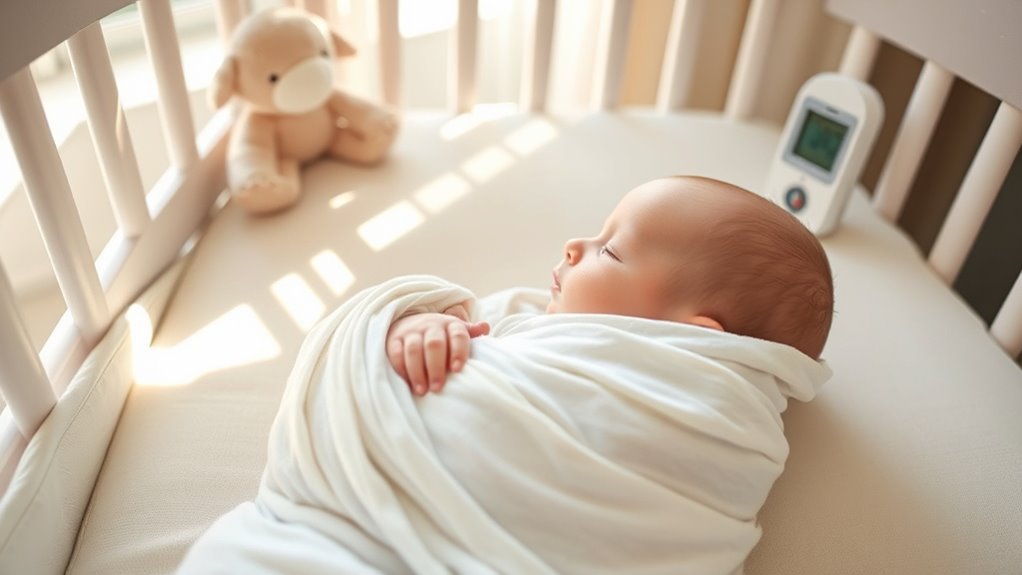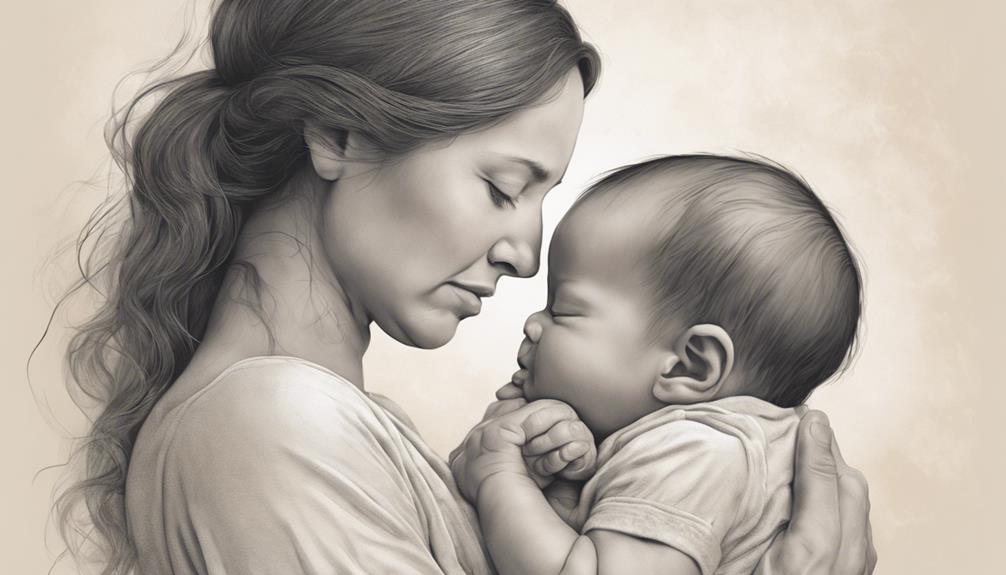Swaddling can help your newborn sleep longer and feel secure, while promoting healthy hip development. However, it’s essential to do it safely—ensure your baby sleeps on their back and use proper techniques to avoid overheating or skin irritation. If you’re concerned about risks, try alternative soothing methods like gentle rocking or using a pacifier. To get all the important safety tips and options, keep exploring how to swaddle your little one securely.
Key Takeaways
- Proper swaddling promotes safe sleep, comfort, and hip health while reducing startle reflexes and crying episodes.
- Ensure correct sleep position on the back, use appropriate materials, and avoid overheating to minimize risks.
- Alternatives like gentle rocking and pacifiers can soothe babies safely without the risks associated with swaddling.
- Proper technique, material choice, and regular skin checks are essential to prevent irritation and ensure safety.
- Creating a safe sleep environment with proper positioning and monitoring supports restful sleep without the need for swaddling.
The Advantages of Swaddling for Newborns

Swaddling offers several benefits that can help soothe and calm newborns. One key advantage is its positive effect on sleep patterns. When properly swaddled, your baby feels secure, reducing startle reflexes that can wake them up. This promotes longer, more restful sleep sessions. Additionally, swaddling supports healthy hip development by allowing your baby’s hips to move freely, which is essential for proper joint formation. Using the right technique guarantees that the hips are not constricted, preventing future issues. As your newborn feels snug and safe, you’ll notice fewer crying episodes and more peaceful nights. Proper swaddling can establish a comforting routine, helping your baby settle quickly and develop consistent sleep habits. Ensuring the right swaddling technique is crucial for maintaining healthy hip positioning and overall comfort. Also, understanding the importance of appropriate materials can enhance safety and comfort during swaddling. Being aware of safe swaddling practices can further reduce risks and promote better sleep quality for your infant.
Safety Considerations and Potential Risks

While swaddling can promote better sleep and development, it’s important to be aware of safety considerations to avoid potential risks. One key factor is guaranteeing the correct sleep position; your baby should always sleep on their back to reduce the risk of Sudden Infant Death Syndrome (SIDS). Improper swaddling can also lead to overheating or restrict movement, increasing discomfort or injury. Additionally, watch for signs of skin irritation, which can occur if the fabric is too tight or causes friction. Regularly check your baby’s skin and adjust the swaddle if you notice redness or rashes. Proper technique and attention to your baby’s comfort are vital to minimize risks and ensure safe, restful sleep. Using appropriate headphone types for your child’s needs can also help prevent discomfort during awake times. Ensuring proper air quality in the sleeping environment can further promote safe sleep. As awareness about baby sleep safety continues to grow, parents can better protect their infants during rest.
Alternative Methods to Soothe Your Baby

When traditional swaddling isn’t suitable or desired, there are several alternative methods to soothe your baby effectively. Gentle rocking can mimic the calming motions your baby experienced in the womb, helping them feel secure and relaxed. You can hold your baby in your arms and sway gently or use a rocking chair for a soothing effect. Pacifier use is another proven technique; it can satisfy your baby’s natural sucking reflex, reducing fussiness and helping them settle. Combining these methods can be especially effective—try rocking your baby while offering a pacifier. Additionally, understanding infant calming techniques can guide you in choosing the most appropriate methods for your little one. Recognizing baby sleep cues can also help you respond promptly and prevent overstimulation. Learning about safe sleep practices is essential to ensure your baby’s comfort and safety during calming routines. Remember, every baby responds differently, so experiment with these alternatives to find what comforts your little one best. These simple strategies can help calm your baby safely and comfortably without swaddling.
Frequently Asked Questions
When Should I Stop Swaddling My Baby?
You should stop swaddling your baby around 2 months old or when they start rolling over. At this stage, it’s important to encourage tummy time to develop their muscles and skills. Moving out of swaddling also helps with sleep training, as your baby learns to self-soothe without restrictions. Keep an eye on their development, and gradually introduce other sleep methods for safe, independent sleep.
Can Swaddling Affect a Baby’s Hip Development?
You might worry that swaddling could cause hip dysplasia or developmental delays, but if done correctly, it shouldn’t. Proper swaddling keeps your baby’s hips loose and bent, allowing natural movement. Avoid tight wraps that restrict hip movement, as this can increase risks. When done safely, swaddling supports comfort without harming hip development, reducing the chance of long-term issues like developmental delays or hip dysplasia.
Are There Specific Fabrics Best for Safe Swaddling?
Yes, you should choose baby-safe fabrics and breathable materials for safe swaddling. Opt for soft cotton, muslin, or bamboo fabrics that allow airflow and reduce overheating. These breathable materials keep your baby comfortable and help prevent skin irritation. Avoid synthetic or thick fabrics that trap heat. Always check for gentle, natural fabrics that are free from harmful chemicals, ensuring your baby’s delicate skin stays safe and cozy during sleep.
How Do I Recognize Signs of Over-Heating in a Swaddled Baby?
Imagine your baby’s tiny lamp glowing too brightly—overheating signs are similar. You’ll notice their cheeks flush, sweat on their forehead, or damp hair, indicating temperature regulation issues. Watch for rapid breathing or skin irritation, which can signal they’re too warm. Gently feel their neck or back; if they’re hot or sweaty, loosen the swaddle and cool them down. Keep their environment comfortably cool to prevent overheating.
What Are the Best Alternatives if My Baby Dislikes Swaddling?
If your baby dislikes swaddling, consider using alternative swaddles or sleep sacks designed for comfort and mobility. These options promote safe sleep while allowing natural movement, which can help with sleep training. You might also try gentle rocking or establishing a consistent bedtime routine to soothe your baby. Remember, finding what works best may take some experimentation, but ensuring safety and comfort is key for a good night’s sleep.
Conclusion
Swaddling can be a helpful way to comfort your newborn, but it’s essential to do it securely. Remember, about 20% of sleep-related infant deaths are linked to unsafe sleep practices, including improper swaddling. By following safety tips and exploring alternatives like gentle rocking or white noise, you can soothe your baby effectively while reducing risks. Staying informed and cautious ensures your little one’s sleep is both comforting and safe.









